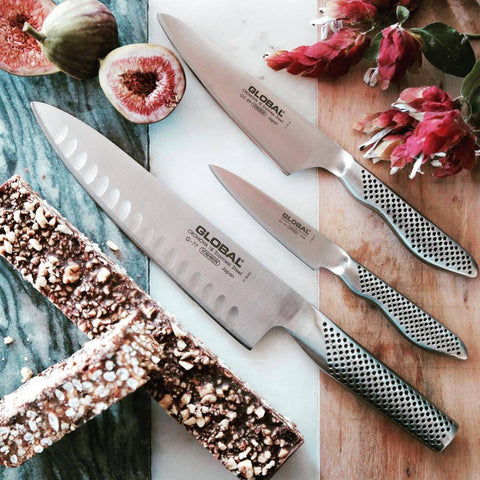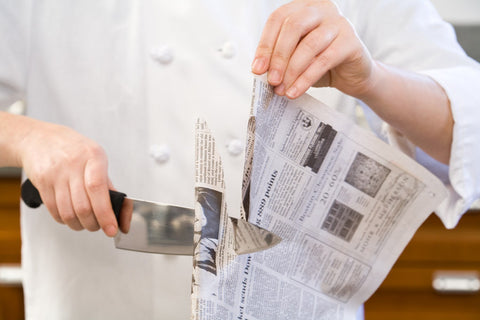How To Care For Your Kitchen Knives
Knives are a pretty important part of every kitchen.
Whether they're on display in a nice and trendy, wooden block or stored away neatly in a cupboard, some good-quality kitchen knives are a must-have!
From Global knives used by professionals to Avanti knives that are suitable for home cooks on a budget, knives are pretty integral to the cooking process.
Since you're using a knife for preparing pretty much everything, it's important that they be sharp otherwise it can be quite dangerous as you're using more pressure and exerting more force to chop, cut or dice with a blunt knife. This may cause you to slip and injure yourself and that's something you definitely want to avoid.
This means that knowing how to look after them should be at the top of your priority list. To help learn what-to-do and all the tips and tricks to keep them in tip-top condition, we've put together a guide that'll have you caring for your knives the proper way in no time!
__________________________________________________________________
Tips On How To Take Care Of Your Kitchen Knives
1. Honing vs Sharpening
It's a well-known fact that even the sharpest of knives will one day get dull. This isn't a fault of the knife, it's simply what happens when they're being used a lot however there is a way you can get them back to their best.
To keep the sharp edge on a knife, you should be honing it regularly (before every use or every couple of uses). The process of honing a knife means you're smoothing out the existing metal, rather than removing a bit of the metal like you would if you were sharpening the knife.
The good news? It's really easy to master this skill especially when you have the Honing Steel by Mundial.
Our recommendation? Using the vertical stroking method is the safest and easiest. Read the steps below:
- Hold the steel vertically with the tip pressed down on your work surface. Make sure your grip is firm so that the steel won't move when you start honing.
- Place the heel of the blade against the top of the steel so that the tip is pointing slightly upward.
- Angle the knife to 15 degrees between the flat side of the blade and the rod.
- Make sure to maintain the angle while honing the knife, slowly pulling it up and down the steel. Repeat this 4-5 times.
- Switch to the other blade and do the same thing!
If you're honing your knives regularly, you'll only have to sharpen them once a year.
2. Wash them by hand
Most modern knives are made from high-quality stainless steel (or something similar) which means they're more likely to be rust-resistant. However, this doesn't mean you can leave your knives dirty for too long after using them.
The acid, water, and other chemicals from the foods you've been cooking can potentially start to wear away the blade, leaving rust or spots on the knife.
The best way to avoid this is to simply wash the knives as soon as you're finished chopping!
Regardless of whether the care instructions say 'dishwasher safe', you should always be washing your knives by hand. Just pop the knives in soapy, hot water to carefully clean them and immediately dry them with a clean cloth.
*Pro-tip* - don't ever let your knives air-dry as they're more prone to developing rust or other blotches.
3. How you store your knives is important
A clean and sturdy knife block is the best way to store your kitchen knives. Luckily for you, most knife sets are sold this way.
Knife blocks ensure your knives are protected from dirt and other kitchen mess and minimises the chance of your knives clashing amongst themselves or rubbing against other things.
If you don't like the idea of pulling out the knives in order to see which ones they are, you could always install a magnetic strip to the inside door of one of your cupboards.
This way you can immediately locate the exact knife you want to use and will prevent them from rubbing against each other.
4. Watch the way you cut
To avoid constantly banging your knives down after you've cut your ingredients, try using a softer cutting technique. This could look like cutting with the point first and gently following through with the rest of the blade.
Not only will this maximise the sharpness of the blade, but this will also protect your cutting surface and make using the knife safer in general.
Having said that, the only acceptable cutting board/mat you should be using is a wooden board however you can use a plastic cutting board, it just won't last as long.
Are My Knives Sharp Enough?
The best way to determine whether or not your knives need sharpening is to put them to the test. The paper test.
Simply, hold a folded, un-creased sheet of newspaper (if you don't have a newspaper because honestly who buys those anymore, you can just a normal piece of copy paper) by one end and make sure the blade is at the top of the paper, and at an angle to slice downward. If the knife doesn't slice through the paper cleanly and easily then it needs to be honed or sharpened.
Try honing it first and if it still doesn't make that much of a difference to how clean/easy the knife slides through the paper, then you'll need to sharpen it.
What Do I Use To Sharpen My Knives?
As we've touched on before, the process of sharpening knives involves removing a little bit of metal from the edges of the knife, and this is something a honing/sharpening steel rod can't do.
To restore a dull knife to its former glory, you have a few options; to organise a knife sharpening company to come and sharpen your knives, to use an electric knife sharpener, to use a manual knife sharpener, or to use a whetstone.
These options all come with different benefits and depend on the level of experience you have or time you want to spend sharpening your knives.
Electric Knife Sharpener
Definitely handy for those of us who are time poor, electric knife sharpeners are very easy to use once you know how to, thanks to the little motorised wheels that spin against the blade, removing the metal for you.
Not only are they very quick to use (it’s roughly about 1-2 minutes of work per knife before they’re as good as new), they have the ability to sharpen knives without any flaws.
Each electric sharpener can be a bit different but generally, they all have the same functions. These include:
- spring-loaded guides to restrict the knife's movement
- aggressive slots to quickly restore the damage and sharpen angles
- multiple grinding slots with different levels of coarseness
Manual Knife Sharpener
Manual knife sharpeners are a bit harder to use but are cheaper than electric ones so if your knives need sharpening on a budget, this product will do the trick!
With manual sharpeners, it's common for them to be formed into a V-shaped chamber with little non-motorised wheels or other abrasive materials on the sides, making it easy for you to pull the knife through.
Some pros of sharpening knives manually include:
- holds the knife steady, ensuring even pressure
- can be stored easily thanks to its slim body
- quick to use
Whetstones
Whetstones can be tricky to use if you're not a professional and you haven't experimented with sharpening knives before but they are extremely effective when handled the right way and are considered the best way to sharpen your knives at home.
Whetstones are often made out of artificial stones with a form of a bonded abrasive texture that's used to provide your knives with a faster cutting action.
While it might take you longer to master this skill, using a whetstone on your knives does come with its benefits. Some of these include:
- extremely adaptable
- can feature a coarse and fine side
- inexpensive













